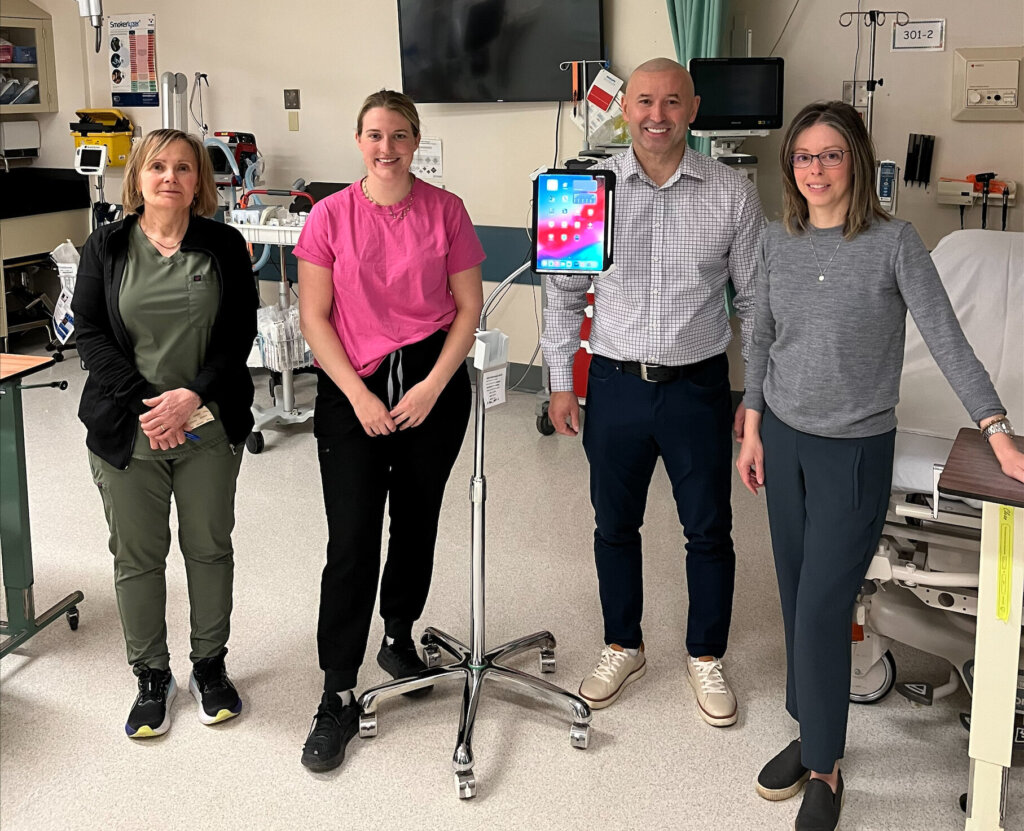It’s 11 p.m. in a small town in northern BC and a patient walks into the emergency department (ED) with a fish hook wedged under their skin.
There are nurses available to help, but the local doctor is home for the night—having worked all day and booked with a full clinic and ED coverage for the morning.
If the nurses haven’t done the procedure in a while—or are new to practice—removing the hook can be daunting.
“It’s not a life-threatening situation, but it’s something best to deal with right away,” explained Dr. Brydon Blacklaws, who co-leads the Rural Urgent Doctor in-aid (RUDi) pathway connected to the Real-Time Virtual Support (RTVS) peer program.
When the nurse can work with a virtual RUDi doctor, both feel comfortable taking on a procedure like this and not waking up the local doctor.
Whether helping with fish hooks, multi-trauma cases, or prolonged resuscitations, RUDi has been providing virtual support to nurses, doctors, and other clinicians in the province since April 2020.

New use for program
But it wasn’t until May 2021 that a new use for the RUDi pathway emerged. Rural communities experiencing staffing problems wanted RUDi to step in to provide overnight virtual coverage of EDs.
The virtual coverage—which sees physician members of the RUDi team provide overnight “first call” and Most Responsible Physician (MRP) support for a team of on-the-ground nurses over the phone or Zoom—has been a success.
The majority of patients who present to a rural ED overnight can be safely managed by a nurse and an experienced RUDi physician virtually.
Brydon said: “The RUDi MRP program is designed for rural communities who are short-staffed and an extra virtual physician overnight can really help the doctors on the ground maintain their sleep, rest, and as much well-being as possible. If absolutely required, a local doc will be called in, but otherwise they try to rest at night, so they can take care of the community and all its needs in the daytime hours. That’s really the crux of what the RUDi MRP Program is designed to do.”
Dr. Rafal Banas, a family physician in Chetwynd who has a primary care practice but also works in the local ED, said that he didn’t think he would be able to continue to take emerg shifts if it were not for RUDi MRP.
Game-changer
With fewer physicians in the community, Rafal said he was often working 24-hour shifts. “After 24 hours in emerg, I’m never in the clinic, so there’s no primary care. Then those folks can’t come to the clinic so they come to emerg, and the emerg gets busier.”
He said having RUDi was a game-changer.
“Having RUDi, RTVS, it has been amazing. I was already physically and mentally exhausted. And being able to go home and somewhat check out mentally, has been needed. It’s not even about keeping me in bed, it’s about mentally being done. I’d just done all these complex people in emerg, and I just need to take a breath and go home and rest.”
“The RUDi MRP program is designed for rural communities who are short-staffed and an extra virtual physician overnight can really help the doctors on the ground maintain their sleep, rest, and as much well-being as possible.”
Rebecca Borton, health services administrator for several Peace region hospital sites, including Tumbler Ridge and Chetwynd, said she had received positive reviews from nurses as well.
“I received a lot of very positive feedback from the group,” she said. “Our nurses have shared specifically that they feel not only very well supported with RUDi, but also more supported with it because they worry about calling our physicians through the night. They know that our physicians have responsibilities the next day, and that we are short physicians right now. So, knowing that they’re not actually interrupting one of those physicians in the middle of the night is probably easing some of their angst or worry.
“The nurses are quite protective of the docs, they know they’re thin on the ground, so they may be taking on the burden of care a bit more when they notice a doc has been overworked.”
New opportunities
Working with the virtual doctor has opened up new opportunities for the nurses as well.
“One of my charge nurses did share that they felt this was actually encouraging them to work to the fullest part of their scope,” Rebecca explained. “This is because, of course, now their assessments and their interactions with the client is weighted a bit more heavily with this model. And so they appreciated that because they like to expand their skillset.”
The removal of a fish hook is an example of this. “They got to participate as the hands-on provider and then, coached, of course, by the RUDi MRP,” Rebecca said.
Brydon said the model is working well, but it was because everyone was working together as a team.
Superheroes
“The nurses are the superheroes of this whole program,” he said. “When a RUDi MRP physician is on shift it has been abundantly clear that it puts more work onto the local nurse.
“They have to do all of their work, plus a lot of the work that the doctor would normally do.
“When the site has a volume and acuity that are manageable under this practice model, then it’s successful. When the patient volumes or acuity are too high, that is when this model of virtual physician and local nurse on the ground can become strained and pinched. We try to limit doing RUDi MRP work to sites where we feel it will work well, and extra physician resources are essential for the site to not go on diversion.”
To learn more about RUDi and the other peer pathways for rural healthcare providers administered by the Rural Coordination Centre of BC, visit the RTVS page.


